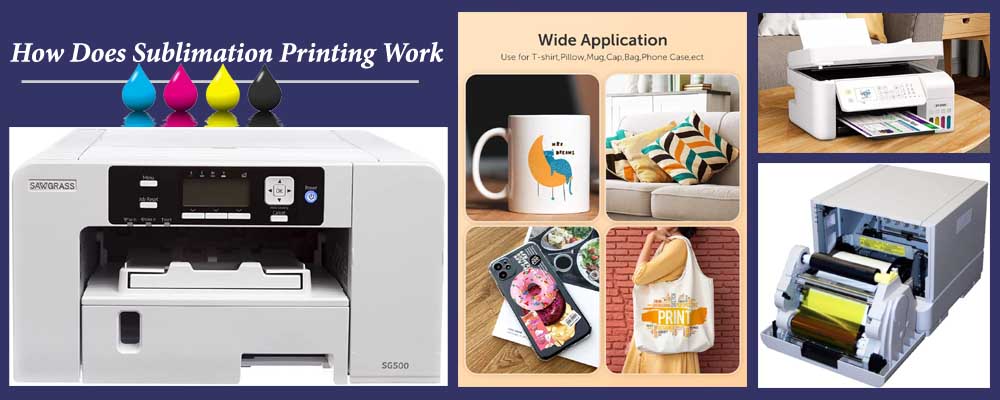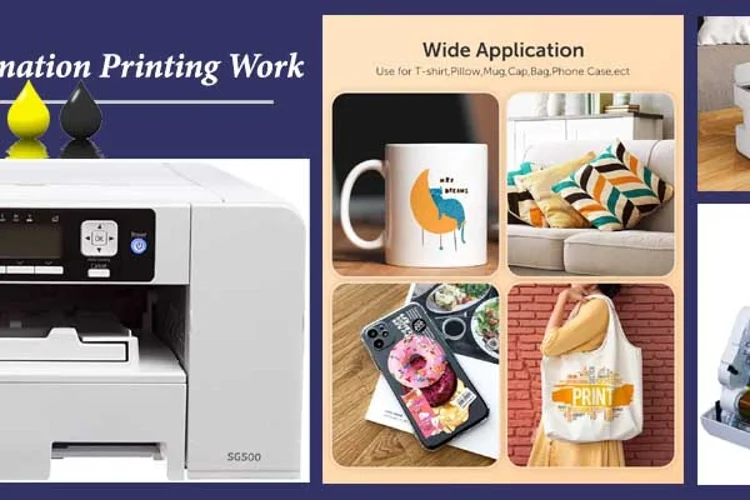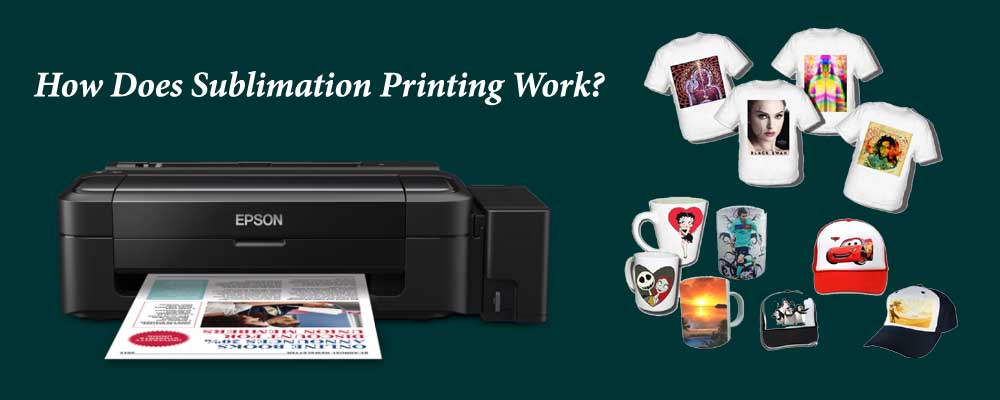How Does Sublimation Printing Work
by Anthony Clark
This article is going to cover the basics of how does sublimation printing work. Sublimation printing is a type of inkjet printing that was first patented in 1959, and it has been used in many industries since then. It can produce photo-quality prints on textiles, including t-shirts, bags, hats, and more!
This article will discuss how sublimation printing works to decide if it will work for your business needs.
Contents
- What Is Sublimation Printing?
- Why Choose Sublimation Printing?
- How Does Sublimation Printing Work?
- The Designs That Work Well with Sublimation Printing
- The Designs That Don’t Work Well with Sublimation Printing
- Which Materials Can be Printed with Sublimation?
- Advantages of Sublimation Printers
- Disadvantages of Sublimation Printing
- Which Printers are Suitable as Sublimation Printers?
What Is Sublimation Printing?
Polaroid Corporation introduced Sublimation Printing in 1959 after discovering how it could be used for transferring images onto photo films during manufacturing (instead of using silver nitrate). This method allows for high-quality prints and has been used to print disposable credit cards, clothing tags, photo identification badges, among other things. It also uses a print ribbon to transfer an image onto specially coated paper, which then heats and transfers the dye from the paper into a rubber-like polymer coating on top of it.

This process causes the dye to penetrate the coating and become one with it, which is how this type of printing gets its name.
Why Choose Sublimation Printing?

If you’re looking to print a large number of products quickly with vibrant colors that don’t fade or smear over time like other types of inkjet printers do (like water-based), then sublimation is your best option.
The benefits of this type of printer are related to how it works: dye molecules are printed onto a substrate through heat rather than being applied as pigment particles which cause an image’s surface area to be visible. This means that when the design is complete, there will be no white spots left.
How Does Sublimation Printing Work?

The process starts by adding ink to a print ribbon that’s wrapped around an ink-jet printer head. Then, when you press down on the paper for sublimation prints, heat from your fingers starts the sublimation process.
- ink turns into a gas and is transferred to the paper, which causes it to heat up in that area
- The printing head then moves down one line while simultaneously spraying new color onto the freshly heated surface of the paper. This continues until you’ve printed an entire page worth of images with just black and white colors as opposed to a full-color printer where each pixel requires three different colored dots: cyan, magenta, and yellow (CMYK)
- In addition to this, faster print time for monochrome printers is lower costs because they can use less expensive dyes instead of CMYK pigments. That can be expensive on their own or mixed in specific ratios depending on how dark someone wants their print to show up on the paper.
- For the most part, monochrome printers are used for printing text on white backgrounds or black ink on dark paper.
If you’re looking to print full-color images, it’s best to use a CMYK printer and be prepared with more expensive pigments.
A Few Things to Keep in Mind:
- Your paper should be close to the same shade of white or black as your ink. If you’re using a dark color, make sure that the other colors are also darker than usual. Otherwise, it might look faded and unnatural on glossy papers.
- Colorless oil-based inks will not work with these printers because they do not absorb into the print surface well enough, which causes them to smear when used for sublimation printing without adding more coats of resin overtop or coating beforehand. It’s best practice to use pigment-based ink for this process instead.
- To get full-color prints, some people prefer Creative Cloud Printing so you can have all your files uploaded and printed automatically to print on the sublimation printing process.
- There are also other benefits of a UV printer because they can produce promotional items with images printed onto them and then laminated. This is mainly done for high-end events such as weddings, conferences, trade shows, etc., but it’s best to want something with more longevity than paper or cardboard.
- The limitations of this type of printing machine usually mean that only one color at a time can be printed. Hence, designs need to be created accordingly and should not contain multiple colors in an area since each layer will overlap the previous one before curing, which could cause any design elements like text or logos to look distorted due to being stretched thin over too big an area.
The Designs That Work Well with Sublimation Printing
All designs do not work well with Sublimation Printing, but some types of images do.
Textures
This is a great way to add interest and texture to an image while still keeping it fluid.
Gradients a shading
Gradients can be a good idea for subtlety in the design or as part of its overall look while adding depth and dimensionality on surfaces like wood, metal, or glass. Shading can work quite nicely, too, if you want something more dramatic than just solid colors.
Solid Colors
These designs will not have any issues when printed onto sublimation, so they’re perfect for logos, text, and other essential elements – keep them simple!
The Designs That Don’t Work Well with Sublimation Printing
Some designs do not work well with sublimating printing, like-
Photographs
A photograph should not be printed onto a sublimation printer. As the print progresses, any temperature changes will cause the colors to distort. The ink will also continue to move and spread even after it has dried up, which can lead to unintended smears or patches of different hues that look like an abstract painting rather than an image you want people looking at for long periods.
Block
Block color does not show good results in sublimating printing. So it will not be an excellent decision to print these types of designs on a sublimation printer.
Thin Lines
Thin lines, such as those found in many tattoo designs or a fine line drawn by the pen, are not suitable for printing onto fabrics because they can be lost when the ink is applied to fabric during the process.
It is always best to keep your design elements simple!
Which Materials Can be Printed with Sublimation?
These materials are:
-Clothing
-Plastic, Metal, or other hard surfaces (i.e., mugs)
-Wooden boards for wall art
-ceramic mugs
Advantages of Sublimation Printers
The sublimating printer has a lot of advantages.
- Sublimation printers are a cost-effective way to print on fabrics, and they can work with high-quality, detailed designs. The sublimating printer also has a lot of advantages.
- Better color consistency than screen printing or dye sublimation
- Their production process does not require additional chemicals like latex ink or water-based inks as it uses heat and pressure to create the printed image on the fabric!
- sublimation printing is cost-effective, and it gives output quickly
- Sublimation printers are also eco-friendly. The inks do not contain any harmful chemicals and are water-soluble, so it does not stick to the environment or clothes!
- Logos, motives, cellphone cases, keyrings, cups or medals, and photos turn out perfectly.
Disadvantages of Sublimation Printing
Sublimation printing has some disadvantages. They are-
- Require a particular printer for sublimating printing
- The printer needs a specific cartridge to transfer the ink into its media. The cartridges are comparatively pricey, with prices ranging from $75 to $200 for one color or $300-900+ for full CMYK color printers.
- Sublimation inks tend to be costlier than other printing methods. In addition, because they are water-soluble, they need to be printed on paper coated with polyurethane, so it doesn’t get ruined by rain when hung outside.
- The process is time-consuming compared to screenprinting, offset printing, and digital printing, which means more jobs per hour and less accuracy since there is no way to adjust density after printout.
- Hard to printing white color
Which Printers are Suitable as Sublimation Printers?
There are a variety of printers that can be used as sublimation printers. The most popular printer is the Roland VersaCamm SP-300 12 full color, and it costs $1599. It has a printing width of 12 inches wide and prints at up to 300 mm per second with a maximum resolution of 360dpi x 720dpi (720×360).
The Canon Selphy CP1200 offers an affordable option for those on a budget and offers four inks: black, cyan, magenta, and yellow, which are water-resistant. This makes them suitable for outdoor use without any risk of damage from raindrops or other things like snowfall or hail.
There are many more options out there that can be purchased online through different retailers such as Amazon or other companies specializing in printers.
In conclusion, sublimation printing is a fast and efficient way to create high-quality artwork without harmful chemicals. It’s also eco-friendly!
 |  |  |  |

About Anthony Clark
Anthony Clark always had a passion for digital drawing and printing ever since he was young. He would wander around his parents' house in Phoenix, Arizona drawing various things with his older digital tablet. Be it just a memory collection or a portrayal of anything: objects, parents, school, events, etc. He received his BA in Graphic Design at San Jose State University - the heart of Silicon Valley. Now Mr. Clark is excited to present his experience coupled with some colorful dips to help shape the future of printing.
Thoughts on "How Does Sublimation Printing Work"
 |  |  |  |
Get some FREE Gifts. Or latest free printing books here.
Disable Ad block to reveal all the secret. Once done, hit a button below
 |  |  |  |